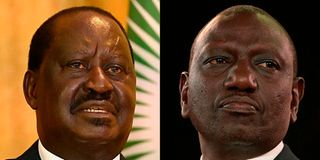For Raila Odinga, William Ruto, it’s time to learn from the numbers

Azimio la Umoja presidential candidate Raila Odinga (left) and his UDA counterpart William Ruto.
The Raila Odinga campaign will probably be celebrating polls showing him stretching his lead in the presidential contest, while Dr William Ruto’s team will be denouncing the numbers as fake and contrived to influence the results.
It is indeed an established feature of Kenyan democracy that contenders will happily embrace favourable opinion polls, but angrily denounce those where the numbers don’t favour them.
For much of last year when Deputy President Ruto was comfortably ahead in all the surveys, he had absolutely no complaints, while Mr Odinga, who was trailing, reflexively dismissed the numbers.
Now it is Mr Odinga purring with satisfaction as a succession of polls, the latest just a week to the August 9 election, show that he has not just closed the gap on Dr Ruto, but stretched a narrow lead beyond the dead-heat previously recorded.
Since what seemed like an unassailable lead started dissipating, Dr Ruto has made it a staple of his rallies to rage against the pollsters, media, his own government and every other entity he can rope into what he sees as a giant conspiracy to undermine his presidential campaign. The Nation Media Group, Infotrak and Ipsos surveys released yesterday all show Mr Odinga stretching his lead to between 6 and 9 percentage points. The lead, significantly, is beyond the margin of error unlike other recent polls which presented a statistical dead heat.

However, celebrations in the Azimio la Umoja One Kenya camp should be tempered by a number of factors. One is the basic acknowledgement that polling may be a science, but a rather inexact one. In Kenya, in particular, there is a history of final polls in the run-up elections ending up widely off the mark against actual results.
This is not just a Kenyan phenomenon, but has also been recorded in countries where political opinion polling is much more entrenched. A clear example was the 2016 United States presidential elections, where all projections were for a Hilary Clinton victory, only for Donald Trump to turn the tables.
Also worth noting for both the Odinga and Ruto camps is that all the polls show a substantial number of undecided voters that are close to or more than the margin between the two.
The lesson for Mr Odinga is that it is not yet won, and for Dr Ruto that all is not lost.
Before breaking out the champagne bottles or descending into bouts of rage, what the two candidates should be doing is closely studying the numbers and trying to figure out where and how they can coax out just a few more votes. It would be wise to treat the polls not as indications of victory or defeat, but as numbers to be keenly studied in regard to trends and patterns that will help craft winning strategies in the remaining few days.
One key lesson is that this election will be decided on turnout and where the undecided votes ends up. Thus, both campaigns should be turning attention to whipping the vote in their respective strongholds, and persuading the undecided.
Both campaigns should also be paying microscopic attention to shifts in votes within regions, and even specific counties, particularly in battleground areas where slight shifts can have major bearings on the outcome. If Mr Odinga, for instance, looked at his vote projections against the figures garnered in 2017, he would not be sitting pretty.
In the populous Mr Kenya backyard of President Uhuru Kenyatta, for instance, he in the previous two elections won less than 3 per cent of nearly five million votes. He would have expected to reap a handsome bounty on the back of his alliance with the President, but the region has largely rebelled and thrown its weight behind Dr Ruto.
Mr Odinga would probably have been banking on anything up to 40 per cent of the Mt Kenya vote, but poll after poll shows him struggling to break 25 per cent. That is still an impressive jump from 3 per cent, but far short of projected dividends from the handshake. The Mt Kenya numbers also do not show any major gain from Mr Odinga’s selection of Ms Martha Karua as running mate.

Although Dr Ruto dominates Mt Kenya, the 63 to 68 per cent he is recording between the Nation and Ipsos polls should offer scant comfort against the 97 per cent earned when he paired with President Kenyatta. That is a large loss, which is not countered by the inroads he is making in Mr Odinga’s big support base in Western and Coast regions.
Also worth close attention from both camps is how Mr Odinga is inexplicably eating into Ruto strongholds in parts of the Rift Valley, counties such as Uasin Gishu and Nandi, where he could barely get out of single digits in the past.
The numbers from western Kenya should also be of interest to Dr Ruto, who at some point might have to decide who between Mr Musalia Mudavadi and Mr Moses Wetang’ula added more value to his campaign.
These are just but a few examples of why the two campaigns should not be looking just at the overall national poll number, but break their analysis down to the smallest units.





